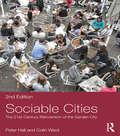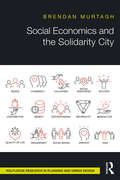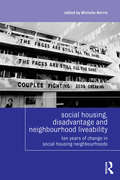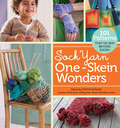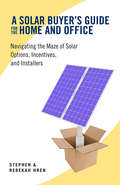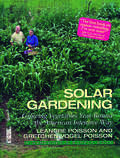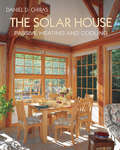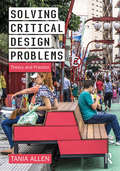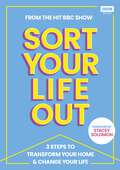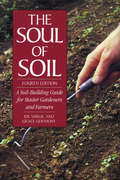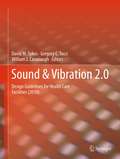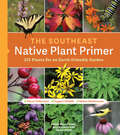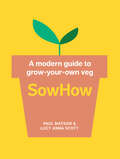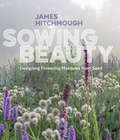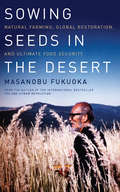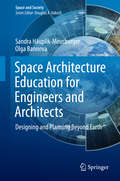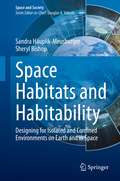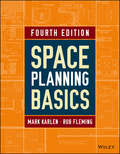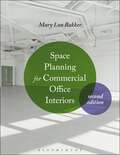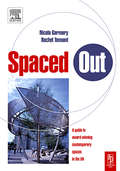- Table View
- List View
Sociable Cities: The 21st-Century Reinvention of the Garden City (Planning, History and Environment Series)
by Peter Hall Colin WardPeter Hall and Colin Ward wrote Sociable Cities to celebrate the centenary of publication of Ebenezer Howard’s To-morrow: A Peaceful Path to Real Reform in 1998 – an event they then marked by co-editing (with Dennis Hardy) the magnificent annotated facsimile edition of Howard’s original, long lost and very scarce, in 2003. In this revised edition of Sociable Cities, sadly now without Colin Ward, Peter Hall writes: ‘the sixteen years separating the two editions of this book seem almost like geological time. Revisiting the 1998 edition is like going back deep into ancient history’. The glad confident morning following Tony Blair’s election has been followed by political disillusionment, the fiscal crash, widespread austerity and a marked anti-planning stance on the part of the Coalition government. But – closely following the argument of Good Cities, Better Lives: How Europe discovered the Lost Art of Urbanism (Routledge 2013), to which this book is designed as a companion – Hall argues that the central message is now even stronger: we need more planning, not less. And this planning needs to be driven by broad, high-level strategic visions – national, regional – of the kind of country we want to see. Above all, Hall shows in the concluding chapters, Britain’s escalating housing crisis can be resolved only by a massive programme of planned decentralization from London, at least equal in scale to the great Abercrombie plan seventy years ago. He sets out a picture of great new city clusters at the periphery of South East England, sustainably self-sufficient in their daily patterns of living and working, but linked to the capital by new high-speed rail services. This is a book that every planner, and every serious student of policy-making, will want to read. Published at a time when the political parties are preparing their policy manifestos, it is designed to make a major contribution to a major national debate.
Social Economics and the Solidarity City
by Brendan MurtaghSocial Economics and the Solidarity City explores the impact and potential of the social economy as a site of urban struggle, political mobilization and community organization. The search for alternatives to the neoliberal logic governing contemporary cities has often focused on broad and ill-defined political, social and environmental movements. These alternatives sometimes fail to connect with the lived realities of the city or to change the lives of those exploited in neoliberal restructuring. This book seeks to understand the capacity of the social economy to revitalize urban ethics, local practices and tangible political alterity. Providing a critical account of the social economy and its place in urban and state restructuring, this book draws on a range of international cases to argue that the social economy can be made a transformative space. Evaluating community enterprises, social finance, and solidarity economics, author Brendan Murtagh maps the possibilities, contradictions and tactics of moving the rhetoric of the just city into local and global action.
Social Economics and the Solidarity City
by Brendan MurtaghSocial Economics and the Solidarity City explores the impact and potential of the social economy as a site of urban struggle, political mobilization and community organization. The search for alternatives to the neoliberal logic governing contemporary cities has often focused on broad and ill-defined political, social and environmental movements. These alternatives sometimes fail to connect with the lived realities of the city or to change the lives of those exploited in neoliberal restructuring. This book seeks to understand the capacity of the social economy to revitalize urban ethics, local practices and tangible political alterity. Providing a critical account of the social economy and its place in urban and state restructuring, this book draws on a range of international cases to argue that the social economy can be made a transformative space. Evaluating community enterprises, social finance, and solidarity economics, author Brendan Murtagh maps the possibilities, contradictions and tactics of moving the rhetoric of the just city into local and global action.
Social Housing, Disadvantage, and Neighbourhood Liveability: Ten Years of Change in Social Housing Neighbourhoods (Housing and Society Series)
by Michelle NorrisIn a groundbreaking longitudinal study, researches studied seven similar social housing neighbourhoods in Ireland to determine what factors affected their liveability. In this collection of essays, the same researchers return to these neighbourhoods ten years later to see what’s changed. Are these neighbourhoods now more liveable or leaveable? Social Housing, Disadvantage and Neighbourhood Liveability examines the major national and local developments that externally affected these neighbourhoods: the Celtic tiger boom, area-based interventions, and reforms in social housing management. Additionally, the book examines changes in the culture of social housing through studies of crime within social housing, changes in public service delivery, and media reporting on social housing. Social Housing, Disadvantage and Neighbourhood Liveability offers a new body of data valuable to researchers in Ireland and abroad on how to create more equitable and liveable social housing.
Social Housing, Disadvantage, and Neighbourhood Liveability: Ten Years of Change in Social Housing Neighbourhoods (Housing and Society Series)
by Michelle NorrisIn a groundbreaking longitudinal study, researches studied seven similar social housing neighbourhoods in Ireland to determine what factors affected their liveability. In this collection of essays, the same researchers return to these neighbourhoods ten years later to see what’s changed. Are these neighbourhoods now more liveable or leaveable? Social Housing, Disadvantage and Neighbourhood Liveability examines the major national and local developments that externally affected these neighbourhoods: the Celtic tiger boom, area-based interventions, and reforms in social housing management. Additionally, the book examines changes in the culture of social housing through studies of crime within social housing, changes in public service delivery, and media reporting on social housing. Social Housing, Disadvantage and Neighbourhood Liveability offers a new body of data valuable to researchers in Ireland and abroad on how to create more equitable and liveable social housing.
Sock Yarn One-Skein Wonders®: 101 Patterns That Go Way Beyond Socks! (One-Skein Wonders)
by Judith DurantSock yarn isn&’t just for socks anymore! Veteran knitter Judith Durant presents 101 original projects that can be created from just a single skein of sock yarn, including adorable baby clothes, warm hats, beautiful scarves, and even a dog sweater. A quick and creative way to use up leftovers, many of these projects knit up in less than three hours. Adapted from designs contributed by yarn shops and crafters from throughout North America, knitters of all types will delight in these fun and stylish creations.
A Solar Buyer's Guide for the Home and Office: Navigating the Maze of Solar Options, Incentives, and Installers
by Stephen Hren Rebekah HrenSolar power, once a fringe effort limited to DIY enthusiasts, is now fast becoming mainstream. Many home and business owners are curious about solar electric and solar thermal systems, and wonder how to go about getting a clean energy generation system of their own. The vast majority will hire a professional installer to do the job. But what should they be asking of these installers? What system makes the most sense for their home or office: solar electric, solar hot water, solar heating, or some combination of these? A Solar Buyer's Guide for the Home and Office explains the options so that property owners can make the right choices both for their energy needs and their financial security. Understanding how solar power systems work will enable readers to be informed customers when dealing with professional installers-the book also provides advice on how to select a qualified installer and understand the expanding variety of tax credits and other incentives that are popping up around the country. The market for solar systems has been growing at an exponential rate and strong tax credits ensure continued growth even in a sluggish economy. Many of those who would like to catch this undeniable wave of the future are held back by widespread confusion. A Solar Buyer's Guide for the Home and Office clears the air, allowing property owners to move forward with confidence to make their homes and offices more comfortable, environmentally sound, and secure against wild swings in energy prices.
Solar Gardening: Growing Vegetables Year-Round the American Intensive Way (Real Goods Independent Living Bks.a\real Goods Independent Living Book)
by Leandre Poisson Gretchen Vogel Poisson Robin WimbiscusSolar Gardening shows how to increase efforts of the sun during the coldest months of the year and how to protect tender plants from the intensity of the scorching sun during the hottest months through the use of solar "mini-greenhouses." The book includes instructions for building a variety of solar appliances plus descriptions of more than 90 different crops, with charts showing when to plant and harvest each. The result is a year-round harvest even from a small garden. In Solar Gardening the Poissons show you how to: Dramatically increase the annual square-foot yield of your garden. Extend the growing and harvest season for nearly every kind of vegetable. Select crops that will thrive in the coldest and hottest months of the year, without artificial heating or cooling systems. Build solar appliances for your own garden. Armed with nothing but this book and a few simple tools, even novice gardeners can quickly learn to extend their growing season and increase their yields, without increasing the size of their garden plot.
The Solar House: Passive Heating and Cooling (Real Goods Solar Living Bks.)
by Daniel D. ChirasPassive solar heating and passive cooling—approaches known as natural conditioning—provide comfort throughout the year by reducing, or eliminating, the need for fossil fuel. Yet while heat from sunlight and ventilation from breezes is free for the taking, few modern architects or builders really understand the principles involved. Now Dan Chiras, author of the popular book The Natural House, brings those principles up to date for a new generation of solar enthusiasts. The techniques required to heat and cool a building passively have been used for thousands of years. Early societies such as the Native American Anasazis and the ancient Greeks perfected designs that effectively exploited these natural processes. The Greeks considered anyone who didn't use passive solar to heat a home to be a barbarian! In the United States, passive solar architecture experienced a major resurgence of interest in the 1970s in response to crippling oil embargoes. With grand enthusiasm but with scant knowledge (and sometimes little common sense), architects and builders created a wide variety of solar homes. Some worked pretty well, but looked more like laboratories than houses. Others performed poorly, overheating in the summer because of excessive or misplaced windows and skylights, and growing chilly in the colder months because of insufficient thermal mass and insulation and poor siting. In The Solar House, Dan Chiras sets the record straight on the vast potential for passive heating and cooling. Acknowledging the good intentions of misguided solar designers in the past, he highlights certain egregious—and entirely avoidable—errors. More importantly, Chiras explains in methodical detail how today's home builders can succeed with solar designs. Now that energy efficiency measures including higher levels of insulation and multi-layered glazing have become standard, it is easier than ever before to create a comfortable and affordable passive solar house that will provide year-round comfort in any climate. Moreover, since modern building materials and airtight construction methods sometimes result in air-quality and even toxicity problems, Chiras explains state-of-the-art ventilation and filtering techniques that complement the ancient solar strategies of thermal mass and daylighting. Chiras also explains the new diagnostic aids available in printed worksheet or software formats, allowing readers to generate their own design schemes.
Solving Critical Design Problems: Theory and Practice
by Tania AllenSolving Critical Design Problems demonstrates both how design is increasingly used to solve large, complex, modern-day problems and, as a result, how the role of the designer continues to develop in response. With 13 case studies from various fields, including program and product design, Tania Allen shows how types of design thinking, such as systems thinking, metaphorical thinking, and empathy, can be used together with methods, such as brainstorming, design fiction, and prototyping. This book helps you find ways out of your design problems by giving you other ways to look at your ideas, so that your designs make sense in their setting. Solving Critical Design Problems encourages a design approach that challenges assumptions and allows designers to take on a more critical and creative role. With over 100 images, this book will appeal to students in design studios, industrial and product design, as well as landscape and urban design.
Solving Critical Design Problems: Theory and Practice
by Tania AllenSolving Critical Design Problems demonstrates both how design is increasingly used to solve large, complex, modern-day problems and, as a result, how the role of the designer continues to develop in response. With 13 case studies from various fields, including program and product design, Tania Allen shows how types of design thinking, such as systems thinking, metaphorical thinking, and empathy, can be used together with methods, such as brainstorming, design fiction, and prototyping. This book helps you find ways out of your design problems by giving you other ways to look at your ideas, so that your designs make sense in their setting. Solving Critical Design Problems encourages a design approach that challenges assumptions and allows designers to take on a more critical and creative role. With over 100 images, this book will appeal to students in design studios, industrial and product design, as well as landscape and urban design.
SORT YOUR LIFE OUT: 3 Steps to Transform Your Home & Change Your Life
by The teamThe first official book from the life-changing BBC One show, Sort Your Life Out will have you falling back in love with your home in three simple steps:1. STRIP - how to let go and clear out the clutter (when you don't have a warehouse to hand)!2. SORT - time to sell, donate, recycle and upcycle.3. SYSTEMISE - learn how to organise, fold and store in a way that is manageable and sustainable.Filled with every tip and trick from your favourite experts Stacey, Dilly, Iwan and Rob, this empowering book will give you the tools to transform your home and get that Sort Your Life Out mindset.
The Soul of Soil: A Soil-Building Guide for Master Gardeners and Farmers, 4th Edition
by Joseph Smillie Grace GershunySoil is the basis not only for all gardening, but for all terrestrial life. No aspect of agriculture is more fundamental and important, yet we have been losing vast quantities of our finite soil resources to erosion, pollution, and development. Now back in print, this eminently sensible and wonderfully well-focused book provides essential information about one of the most significant challenges for those attempting to grow delicious organic vegetables: the creation and maintenance of healthy soil. Chapter 2, "Understanding the Soil System," is alone worth the price of admission. Gershuny and Smillie give lay readers and experts a clear explanation of subjects--soil life and nutrient cycles--that have confounded most authors. Nowhere will the reader find simpler and more coherent descriptions of key concepts including cation exchange capacity and chelation. There are other books about soil available, including Grace Gershuny's comprehensive Start with the Soil, and there are books that feature chapters on soil building. What distinguishes The Soil of Soilis the authors' concise presentation; they give readers important information, including technical essentials, without getting bogged down in scientific or quasiscientific mumbo-jumbo. In addition, useful tables list specific compost materials, green manures, and other resources that allow growers to translate into action the more general information provided by the book. The soil-building techniques featured include: Organic matter management Building and maintaining humus On-site composting Green manures and rotations Cultivation and weed control Nutrient balances and soil testing Using mineral fertilizers Planning for organic certification Updates to the 1999 edition include analysis of Proposed Rules for the National Organic Standards, and expanded recommendations for private testing services and soil-testing equipment for home gardeners and organic farmers. All of us involved in the cultivation of plants--from the backyard gardener to the largest farmer--need to help regenerate a "living soil," for only in the diversity of the soil and its creatures can we ensure the long-term health of ourselves and our environment. The Soul of Soil offers everyone a basic understanding of what soil is and what we can do to improve our own patch of it. Seen in this light, this practical handbook will be an inspiration as well.
Sound & Vibration 2.0: Design Guidelines for Health Care Facilities
by David Sykes William J. Cavanaugh Gregory C. TocciThis document was commissioned by the Facility Guidelines Institute as the sole reference for acoustics in health care facilities. It was written by the Health Care Acoustics Working Group, a permanent committee of the Acoustics Research Council (ARC), comprised of members of leading professional societies in acoustics, noise control engineering, acoustical consulting and related professions. ARC organized the health care Working Group in 2004-5 drawing its members from ten constituencies that range from medicine to law, public policy, architecture, design and engineering in order to provide constructive, guidance on sound and vibration based on research and best practices. Sound and Vibration 2.0 has been adopted as the sole reference standard for acoustics in health care facilities by: the 2010 FGI/ASHE "Guidelines for the Design and Construction of Healthcare Facilities" (used in 60 countries); the US Green Building Council’s "LEED for Healthcare" (used in 87 countries); The Green Guide for Health Care V2.2; and the International Code Council's IGCC (2011).Sound and vibration are topics of increasing prominence in the design, construction, and operation of healthcare facilities. A satisfactory acoustical environment in a healthcare facility is now viewed as an essential component of effective healthcare.Sensible acoustical and privacy planning in the early design stages of a healthcare facility project can be solved effectively and affordably with a few strokes of the designer's pencil. The recommended minimum design requirements presented in this work are therefore intended to aid designers in achieving satisfactory acoustical and privacy environments in healthcare facilities. This handbook includes comprehensive, practical, and measureable guidelines for all aspects of acoustics in the design, construction, and evaluation of all types of healthcare facilities, including large general hospitals, specialized patient care facilities, and ambulatory patient care facilities.
The Southeast Native Plant Primer: 225 Plants for an Earth-Friendly Garden
by Larry Mellichamp Paula GrossMore homeowners than ever before are adding native plants to their gardens. This book shares the best plant choices for the Southeast and details how gardeners can grow them successfully.
SowHow
by Paul Matson Anna Lucy ScottWhen you’re growing veg for the first time it can be hard to know where to start and even more difficult to find inspiring advice that isn’t completely incomprehensible… Enter SowHow – the innovative grow guide for the modern gardener. With its fresh, bright design and clear-cut know-how, this clever little book provides all the expert advice and encouragement you need to get growing. You’ll find entries on 30 easy-grow vegetables to sow throughout the seasons, from kale to runner beans and carrots to cucamelons, plus ideas for herbs, edible flowers and advice on cultivating your own cocktail garden. SowHow breaks down the key steps of sowing, planting and harvesting each featured vegetable into understandable bite-sized chunks using straightforward language and smart infographics. Plus, the essential start-up advice covering everything from top tools and cunning crop rotations, to uncomplicated compost and the lowdown on mulches, will make you a pro in no time. Complete with simple cooking suggestions, shrewd storage info and creative gardening hacks, this unique, comprehensive companion will transform your grow space into a hot bed for leeks, beets and all your other veggie friends. So whether you are looking to fill a garden, an allotment, or a patio pot, get going and grow with SowHow.
Sowing Beauty: Designing Flowering Meadows from Seed
by James HitchmoughSowing Beauty is a fresh approach to creating meadow gardens from James Hitchmough, one of the world's most important and groundbreaking landscape designers. Both practical and inspirational, its combination of accessible instruction and lush photography will appeal to style-driven home gardeners and professional landscape and garden designers alike.
Sowing Seeds in the Desert: Natural Farming, Global Restoration, and Ultimate Food Security
by Masanobu Fukuoka Larry KornThe earth is in great peril, due to the corporatization of agriculture, the rising climate crisis, and the ever-increasing levels of global poverty, starvation, and desertification on a massive scale. This present condition of global trauma is not "natural," but a result of humanity's destructive actions. And, according to Masanobu Fukuoka, it is reversible. We need to change not only our methods of earth stewardship, but also the very way we think about the relationship between human beings and nature. Fukuoka grew up on a farm on the island of Shikoku in Japan. As a young man he worked as a customs inspector for plants going into and out of the country. This was in the 1930s when science seemed poised to create a new world of abundance and leisure, when people fully believed they could improve upon nature by applying scientific methods and thereby reap untold rewards. While working there, Fukuoka had an insight that changed his life forever. He returned to his home village and applied this insight to developing a revolutionary new way of farming that he believed would be of great benefit to society. This method, which he called "natural farming," involved working with, not in opposition to, nature. Fukuoka's inspiring and internationally best-selling book, The One-Straw Revolution was first published in English in 1978. In this book, Fukuoka described his philosophy of natural farming and why he came to farm the way he did. One-Straw was a huge success in the West, and spoke directly to the growing movement of organic farmers and activists seeking a new way of life. For years after its publication, Fukuoka traveled around the world spreading his teachings and developing a devoted following of farmers seeking to get closer to the truth of nature. Sowing Seeds in the Desert, a summation of those years of travel and research, is Fukuoka's last major work-and perhaps his most important. Fukuoka spent years working with people and organizations in Africa, India, Southeast Asia, Europe, and the United States, to prove that you could, indeed, grow food and regenerate forests with very little irrigation in the most desolate of places. Only by greening the desert, he said, would the world ever achieve true food security. This revolutionary book presents Fukuoka's plan to rehabilitate the deserts of the world using natural farming, including practical solutions for feeding a growing human population, rehabilitating damaged landscapes, reversing the spread of desertification, and providing a deep understanding of the relationship between human beings and nature. Fukuoka's message comes right at the time when people around the world seem to have lost their frame of reference, and offers us a way forward.
Space Architecture Education for Engineers and Architects: Designing and Planning Beyond Earth (Space and Society)
by Sandra Häuplik-Meusburger Olga BannovaThis book considers two key educational tools for future generations of professionals with a space architecture background in the 21st century: (1) introducing the discipline of space architecture into the space system engineering curricula; and (2) developing space architecture as a distinct, complete training curriculum. Professionals educated this way will help shift focus from solely engineering-driven transportation systems and “sortie” missions towards permanent off-world human presence. The architectural training teaches young professionals to operate at all scales from the “overall picture” down to the smallest details, to provide directive intention–not just analysis–to design opportunities, to address the relationship between human behavior and the built environment, and to interact with many diverse fields and disciplines throughout the project lifecycle. This book will benefit individuals and organizations responsible for planning transportation and habitat systems in space, while also providing detailed information on work and design processes for architects and engineers.
Space Habitats and Habitability: Designing for Isolated and Confined Environments on Earth and in Space (Space and Society)
by Sandra Häuplik-Meusburger Sheryl BishopThis book explores creative solutions to the unique challenges inherent in crafting livable spaces in extra-terrestrial environments. The goal is to foster a constructive dialogue between the researchers and planners of future (space) habitats. The authors explore the diverse concepts of the term Habitability from the perspectives of the inhabitants as well as the planners and social sciences.The book provides an overview of the evolution and advancements of designed living spaces for manned space craft, as well as analogue research and simulation facilities in extreme environments on Earth. It highlights how various current and future concepts of Habitability have been translated into design and which ones are still missing. The main emphasis of this book is to identify the important factors that will provide for well-being in our future space environments and promote creative solutions to achieving living spaces where humans can thrive. Selected aspects are discussed from a socio-spatial professional background and possible applications are illustrated.Human factors and habitability design are important topics for all working and living spaces. For space exploration, they are vital. While human factors and certain habitability issues have been integrated into the design process of manned spacecraft, there is a crucial need to move from mere survivability to factors that support thriving. As of today, the risk of an incompatible vehicle or habitat design has already been identified by NASA as recognized key risk to human health and performance in space. Habitability and human factors will become even more important determinants for the design of future long-term and commercial space facilities as larger and more diverse groups occupy off-earth habitats. The book will not only benefit individuals and organizations responsible for manned space missions and mission simulators, but also provides relevant information to designers of terrestrial austere environments (e.g., remote operational and research facilities, hospitals, prisons, manufacturing). In addition it presents general insights on the socio-spatial relationship which is of interest to researchers of social sciences, engineers and architects.
Space Planning Basics
by Mark Karlen Rob FlemingConquer the complexity of interior design with a logical, methodical approach Space Planning Basics is a definitive introduction and principle resource for thousands of designers. With step-by-step methodology based on the author’s several decades of design experience, this authoritative guide has become the de facto reference for an entire generation of designers. This updated fourth edition includes digitized drawings, diagrams, and matrices throughout, and newly added supplemental photographs. The text has been revised to reflect the latest developments in sustainable and universal design, including coverage of daylighting, benchmarking, LEED system standards, and green code issues. The companion website provides AutoCAD files, intrustor videos and matrices to give you a deeper real-world understanding of the design process. This book is perfect preparation for the NCIDQ exam. Proper space planning goes way beyond sketching a preliminary floor plan. Successful implementation includes a balanced integration of code compliance, system support, and adherence to the client’s functional needs. Sustainability adds a new, important layer of complexity. This book shows you how to approach space planning in a way that ensures all considerations are met, and nothing gets lost in the process. Adopt an organized and comprehensive planning methodology Work effectively with dimensionally challenging spaces Consider building systems, codes, lighting, acoustics, and more Develop advanced skills and conquer new challenges Space planning encompasses many components and processes, making a comprehensive reference necessary for mastery of the field. Space Planning Basics is a thorough, methodical resource that gets you started on the right track, with plenty of room for creativity.
Space Planning Basics
by Mark Karlen Rob FlemingConquer the complexity of interior design with a logical, methodical approach Space Planning Basics is a definitive introduction and principle resource for thousands of designers. With step-by-step methodology based on the author’s several decades of design experience, this authoritative guide has become the de facto reference for an entire generation of designers. This updated fourth edition includes digitized drawings, diagrams, and matrices throughout, and newly added supplemental photographs. The text has been revised to reflect the latest developments in sustainable and universal design, including coverage of daylighting, benchmarking, LEED system standards, and green code issues. The companion website provides AutoCAD files, intrustor videos and matrices to give you a deeper real-world understanding of the design process. This book is perfect preparation for the NCIDQ exam. Proper space planning goes way beyond sketching a preliminary floor plan. Successful implementation includes a balanced integration of code compliance, system support, and adherence to the client’s functional needs. Sustainability adds a new, important layer of complexity. This book shows you how to approach space planning in a way that ensures all considerations are met, and nothing gets lost in the process. Adopt an organized and comprehensive planning methodology Work effectively with dimensionally challenging spaces Consider building systems, codes, lighting, acoustics, and more Develop advanced skills and conquer new challenges Space planning encompasses many components and processes, making a comprehensive reference necessary for mastery of the field. Space Planning Basics is a thorough, methodical resource that gets you started on the right track, with plenty of room for creativity.
Space Planning for Commercial Office Interiors
by Mary Lou BakkerSpace Planning for Commercial Office Interiors, 2nd Edition, provides a thorough and engaging look at the entire process of space planning, from meeting the client for the first time to delivering a beautifully rendered and creative space plan that addresses all of that client's needs. The author takes readers through a step-by-step method that includes establishing client requirements, developing and translating ideas into design concepts, drafting layouts, and ultimately combining these layouts into well-organized, effective floor plans replete with offices, workstations, support rooms, and reception areas. Covering issues such as circulation, spatial and square footage calculations, building codes, adaptation to exterior architecture, ceiling systems, barrier-free designs, and LEED requirements along the way, the text presents all of the key principles, processes, and tasks associated with laying out interior space to optimize the health, safety, and wellness of its occupants. Thoughtfully organized, with useful exercises to help the reader master the entire process and lessons that can be applied to all types of designed interiors, this book is an indispensable learning tool for intermediate-level students in interior design, architecture, facilities management, and construction management as well as professional designers and office managers anticipating a corporate move. This second edition includes a more thorough look at programming and the steps involved, as well as expanded end-of-chapter exercises that focus on initial research.
Spaced Out
by Nicola Garmory Rachel TennantThis beautifully illustrated guide celebrates some of the most significant award winning public spaces in major cities in the UK and Ireland over the last ten years.Dealing with a range of contemporary and innovating designed landscapes from urban spaces to public parks, this book focuses on those that have been awarded the highest design accolade from the Royal Institute of British Architects, The Royal Town andPlanning Institute, The Landscape Institute and The Civic Trust. Focusing on designs in ten major cities, and providing a snappy synopsis of each of the spaces in terms of its design statement, function, location, design team and award commentary, It illustrates tothe reader what makes 'good design' in the public realm, providing both information and inspiration.
Spaced Out
by Nicola Garmory Rachel TennantThis beautifully illustrated guide celebrates some of the most significant award winning public spaces in major cities in the UK and Ireland over the last ten years.Dealing with a range of contemporary and innovating designed landscapes from urban spaces to public parks, this book focuses on those that have been awarded the highest design accolade from the Royal Institute of British Architects, The Royal Town andPlanning Institute, The Landscape Institute and The Civic Trust. Focusing on designs in ten major cities, and providing a snappy synopsis of each of the spaces in terms of its design statement, function, location, design team and award commentary, It illustrates tothe reader what makes 'good design' in the public realm, providing both information and inspiration.
